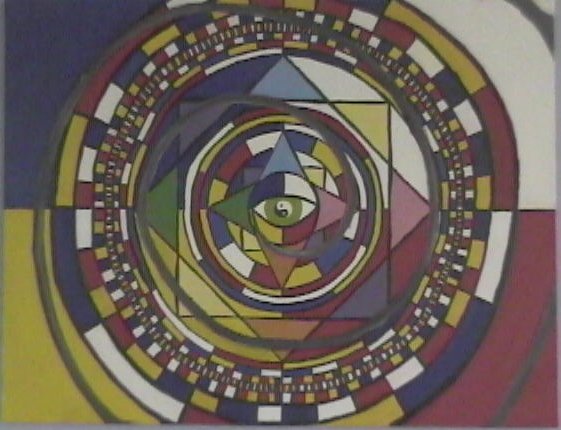Way back in 2009 when I was trying to work in oil, I spent some time exploring the concept of interdependence, cycles, and the four seasons. More accurately put, I built my entire philosophy of life, the universe, the number 42, and how everything works in a cohesive theory of everything; and then I painted a series of paintings based on it.
The paintings aren’t terrible, and they are significant to me in that they helped my find order in my mind at a time when that was a fierce struggle. (Not that this situation has really improved, but it was an especially dark period even though I wasn’t aware of it then.)
The concept of the series is fairly simple. White represents winter, a time of death. Blue represents spring, a time of rebirth and early development. Yellow represents summer, a time of work and real growth. Finally red represents fall, a time of harvest. Each season is made up of smaller periods that are smaller cycles, and blends of those cycles, and the spirals represent our movement through those cycles. The Yin and Yang at the center of these paintings represents the balance that all things eventually come to.
I have stared at and meditated to this painting as often as I have to Vitrunacci Vortex which is based on this series as well…and should probably be considered the fifth and final painting of the series…but because of a few failed pieces, did not end up titled that way.
I will share the other 3 in the series in time but I saw this one recently, and felt it needed to be out there. Not sure if that is for you or I.
Here is the computers thoughts on Zen and Interdependence.
Interdependence from a Zen Perspective
From a Zen perspective, interdependence is a fundamental principle that underpins all aspects of existence. It reflects the interconnectedness of all things, emphasizing that nothing exists in isolation. This concept is deeply rooted in the Buddhist teaching of “dependent origination” (Pratītyasamutpāda), which states that all phenomena arise in dependence upon other phenomena. Here’s an exploration of interdependence through a Zen lens:
1. Interconnected Nature of Reality: Zen teachings highlight that everything in the universe is interconnected. Every action, thought, and event is interlinked, forming a vast web of relationships. The individual and the universe are not separate; rather, they are different expressions of the same underlying reality. This interconnectedness means that our actions impact not only ourselves but the entire cosmos.
2. Non-Self (Anatta): A core Zen teaching is the concept of Anatta, or non-self. It suggests that the self is not an independent, unchanging entity. Instead, what we consider the self is a collection of interconnected experiences, thoughts, and conditions. Understanding non-self helps us see that our identity is intertwined with the world around us, dissolving the boundaries between self and other.
3. Embracing Emptiness (Shunyata): Emptiness, or Shunyata, in Zen does not imply nihilism but the absence of inherent, independent existence. All things are empty of a separate self because they are contingent upon countless causes and conditions. This realization of emptiness leads to a deeper appreciation of the interdependent nature of all phenomena.
4. Compassion and Wisdom: Recognizing interdependence cultivates compassion and wisdom. When we understand that others’ suffering and happiness are interconnected with our own, compassion naturally arises. Wisdom in Zen is the insight into the true nature of reality, seeing beyond the illusion of separateness and understanding the unity of all life.
5. Mindfulness and Presence: Zen practice emphasizes mindfulness and being present in the moment. Through meditation and mindful living, we become more aware of the interconnected web of life. This heightened awareness helps us live more harmoniously with others and the environment, acknowledging our shared existence.
6. Letting Go of Attachment: Interdependence teaches us to let go of attachment to fixed ideas, identities, and material possessions. Everything is transient and ever-changing, shaped by the flow of interdependent causes and conditions. By letting go of attachment, we find freedom and peace in the present moment.
7. The Practice of Zazen: In Zen, the practice of Zazen (seated meditation) embodies interdependence. Through Zazen, practitioners experience the unity of body, mind, and breath, dissolving the illusion of separation. This practice helps cultivate a direct experience of interconnectedness, moving beyond intellectual understanding to a lived reality.
Conclusion: From a Zen point of view, interdependence is not merely a philosophical concept but a lived experience. It calls for a profound shift in perception, where we see ourselves as integral parts of a larger whole. This understanding fosters a life of compassion, wisdom, and harmony, recognizing that our well-being is intimately connected with the well-being of all beings and the natural world. Embracing interdependence leads to a more mindful, compassionate, and enlightened way of living, where we honor the intricate web of life that sustains us all.




One thought on “Interdependence 3: The Big Picture”
Comments are closed.